What is the normal heart rate and how is it controlled?
The normal adult heart beat range is 60 to 100 beats per minute. But it can be higher or lower, normally in certain conditions. Lower during sleep and higher during anxiety, exercise or fever to mention a few conditions.Lower heart rates are called bradycardia and higher heart rates are called tachycardia.
The heart has its own electrical system with a battery or pace-maker called the Sino-Atrial (SA) node which generates the electrical impulses and maintains the heart rate.
Why is the normal heart rate and variability important?
The normal heart rates are important for the brain to receive enough blood to maintain consciousness and its activity.
Why do some people need pacemaker devices to be implanted inside the heart?
Sometimes as one ages, the battery or SA node can get weak (degenerate) just as the battery of a clock and can slow down and can result in very slow heart rates which are insufficient to provide the brain with adequate blood supply which can result in giddiness, fainting or unconsciousness. These patients will need a device called pace-maker to be implanted so that the adequate heart rate is maintained and that the brain and other organs get sufficient blood.
Do all slow heart rates need Permanent Pacemaker Implantation?
In addition to aging there are many conditions which can cause very slow heart rates. Some medications and treatable medical conditions also can cause very slow heart rates and these may be reversible by stopping the medications or treating the medical condition. The non- treatable conditions will need permanent pacemaker implantation. The common indication for a permanent pacemaker are very slow heart rates producing fainting episodes or when a 24 hour ECG monitoring (Holter test) shows that the interval between two consecutive heart beats are more than 2.5 secs. Other comditions are Type I Second degree AV block and high degree AV blocks.
What is Temporary Pacemaker Implantation (TPI)?
Sometimes certain conditions like heart attacks, drug over doses or kidney failure patients can develop very slow heart rates which may need only temporary support till they recover from these conditions. Sometimes the heart rate can be very slow and at times there can be total failure of the SA node to produce any impulses which can cause the heart to stop which is called Cardiac Arrest.
During such conditions, a Temporary Pacemaker Implantation (TPI) is performed often as an emergency and a life-saving procedure. In TPI a lead or wire is passed into the Right Ventricle chamber of the heart from a vein in the leg or neck and is connected to an external battery which is used to provide the required normal heart rate, till recovery. Once the normal heart rate resumes, the TP is removed.
TPI is also performed as a preventive measure, while doing very complex angioplasties and procedures of the heart where there is a risk of very low heart rates or cardiac arrest. (See image)
The image shows a temporary pacing lead placed inside the right ventricle during the performance of a Left Main Bifurcation angioplasty to prevent a fall in heart rate and to prevent cardiac arrest during the angioplasty.
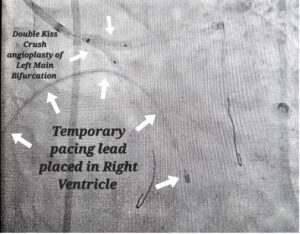
How is the TPI performed?
The TPI is done via a small needle puncture at the groin into the Femoral vein. The femoral vein is a branch of the Inferior venacava which is connected to the Right Atrial chamber of the heart, which is connected to the Right ventricle chamber of the heart. A sheath is placed inside the femoral vein and then the Temporary pacing lead or wire is passed through IVC to RA and into the RV and placed in contact with the RV muscle. The lead is then connected to an external battery which can be set to provide the requisite number of heart beats.
In some patients TPI can be performed from the neck vein called Internal Jugular Vein which is a straight vein connecting to the RA. It is easier to perform the TPI via the neck than leg during an emergency and in absence of cath-lab facilities.
What is a Permanent Pacemaker?
Permanent pacemaker consists of a battery called the pulse generator (PG) and leads or wires (See images). The number of leads placed in the heart may be one (Single chamber pacemaker), where one lead is placed in the right ventricle or two leads (Dual chamber pacemaker), where one lead is placed in the right ventricle and the other is placed in the right atrium. The opposite ends of the leads are connected to the battery which generates the impulses. Some pulse generators can increase the number of beats during activity or exercise called rate-responsive pacemakers.
How is the Permanent Pacemaker Implantation performed?
Procedure: The procedure is performed under local anaesthesia or mild sedation if required. General anaesthesiais mostly not needed. After injecting sufficient local anaesthetic agent in the region below the collar bone or clavicle, an incision or cut is made usually parallel to the collar bone with a surgical blade. (See image of stitch) Thereafter a pocket is madeunder the skin tissue for the PG to be inserted.
Then a needle is used to make one puncture (Single chamber pacemaker) or two punctures (Dual Chamber Pacemaker) as required into the axillary vein. Then sheaths are inserted into the veins. Through the sheath first the right ventricular lead is inserted into the RV. (See image)
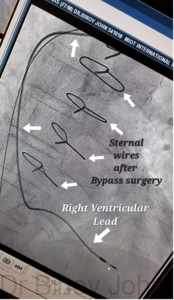
The lead tip is then screwed on to the RV muscle to prevent displacement. (See image)
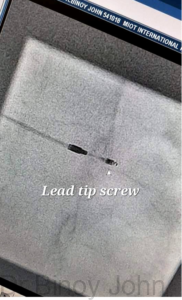
Thereafter,if it is a Dual Chamber Pacemaker, the second lead, which is the RA lead is passed via the second sheath into the Right atrium and can be positioned and screwed if required. (See image)
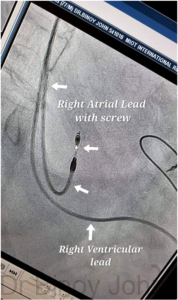
After checking all the lead parameters, the opposite ends of the 2 leads are connected to the battery or Pulse Generator (PG). (See image)
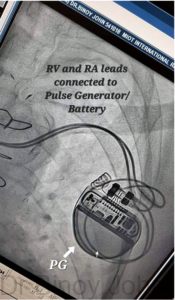
After checking the parameters again the PG is sutured for stability and the wound and skin incision is sutured in layers. (See image)
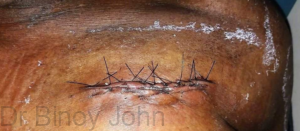
The patient is observed in the hospital, a re-programming of the pacemaker is done and discharged. Non-absorbable stitches are usually removed usually on the 10 th day. Absorbable sutures need not be removed as they get absorbed into the body tissue.
Expertise: Dr Binoy John is an expert in pacemaker implantation having done over hundreds of life saving implants.






